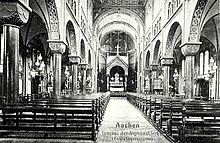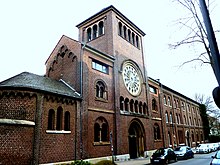Redemptorist Monastery Aachen
The Redemptorist Monastery in Aachen is a former monastery of the Redemptorist Order . The convent building was built in 1862 according to plans by Heinrich Wiethase in neo-Romanesque style , and the monastery church belonging to it was completed in 1865 and consecrated to the founder of the Redemptorist order, Alfonso Maria de Liguori . After the order's withdrawal, the monastery was owned by the Aachen diocese from 1986 to 2005 , which had made it available to the Aachen Jesuit community . It was then sold and converted into an office complex after its profanation . In order to preserve the historical inventory, the church and monastery were placed under monument protection.
history
For the purpose of pastoral care for the “working class of the population”, the Redemptorists founded a branch in Aachen in 1859. At the same time, they acquired a plot of land in the area of Alfonsstrasse and Lothringerstrasse, on which they had a monastery built, which they could move into in 1862. After this monastery had initially received a provisional chapel, the construction of a monastery church began soon after the order had moved in, which was inaugurated in 1865. However, the Redemptorists were only allowed to hold public services after they had promised to read holy mass for the railway workers every Sunday at five o'clock.
From 1873 to 1896, as a result of the Kulturkampf , the order had to leave the monastery in accordance with the implementing provisions of the Jesuit Law of May 20, 1873. The Fathers spent this time in neighboring Vaals , while the monastery buildings were made available to the "Kuetgens-Nellessen'schen Institute" for the training of young craftsmen under Catholic spiritual guidance. After the return of the order, the fathers resumed their “people's missionary” and “men's pastoral care” activities and in the following decades the church developed into a popular confessional church and the place with the most frequent church services in the city.
During the Second World War , between 1941 and 1945, the Redemptorists were again forced to leave their monastery due to the confiscation by the Gestapo , and this time they were taken into private quarters of the Aachen population. In July 1943, the monastery buildings suffered severe damage from an Allied air raid and burned down almost completely. Immediately after the war, the order had the monastery rebuilt and initially set up a provisional emergency chapel. It was not until 1954 that the monastery church of St. Alfons was completely restored.
In 1985 the Redemptorist Provincial Chapter decided to give up the Aachen branch. After their last mass on Easter Monday 1986, they left the city and handed the monastery over to the diocese of Aachen. Until 2005 it served as the Jesuit branch; However, after the number of members had reduced to just three Fathers, the monastery had to be sold for economic reasons and the remaining Fathers joined the Aachen parish of St. Peter until the final dissolution of the Aachen Jesuit branch . After a corresponding renovation, the old Redemptorist monastery has served as a modern building for various office communities since 2008.
Building description
The brick -built monastery building , designed by Wiethase in a U-shape around a spacious inner courtyard, consists of the three-storey convent building and the three-aisled monastery church, which are also connected by a three-storey connecting wing. Through this inner courtyard, which was once the monastery garden, and a newly erected three-story glass hall there is access to all office wings in the monastery and in the monastery church. At the same time, the former main entrance to the church in Lothringerstraße was converted into a side entrance, which is why the current address of the complex is also Alfonsstraße 44.
The church interior had been redesigned several times since 1952, most recently in 2001, when, among other things, a new bluestone altar was made by the architect and artist Thomas Torkler and destroyed after the profanation. The relic of St. Ignatius of Loyola , the founder of the Order of the Jesuits, was preserved by the Jesuits. During the conversion to an office building, the central nave was redesigned as a communicative combination zone with seating niches, printer points, magazine archive and meeting points in the former choir and is available to all office employees. The two side aisles were equipped with an intermediate level resting on their own foundations and divided into single or double offices, which are separated from each other and from the 12 meter higher central nave by glass walls. As a result, the original division of the church naves was preserved and the supporting columns with their capitals and their arched arcades on the new upper floor flow seamlessly into the modern technology. In the former apse as well as in the attached chapel room as well as in the organ loft under the portal rosette and in the church tower, additional office rooms were set up for a wide variety of purposes.
The stained glass windows on the exterior of the church and the large rose window on the west side under the tower have been preserved from the original structure . In contrast, in the previously windowless apse and in the area where the confessionals were located, new window openings were made in the wall in order to allow more daylight to flow in. In order to dampen the typical reverberation effect of a church, most of the surfaces and a large part of the new furniture were provided with sound-absorbing surfaces.
In all of these conversions and installations, particular importance was attached to the fact that both the former monastery character and the historic structures could be preserved.
literature
- Ingeborg Schild , Elisabeth Janssen: The Aachen East Cemetery. Mayersche Buchhandlung, Aachen 1991, ISBN 3-87519-116-1 , pp. 222-223.
- Oliver Meys: St. Alfons, Aachen - office basilica. In: Churches in Transition. Office for Monument Preservation, pp. 126–126 ( pdf )
Web links
- Monastery of St. Alfons , portrait on the pages of the Kaiser Schweitzer architects
- Florian Schweitzer: Conversion of St. Alfons Monastery to baukunst-nrw.de
Individual evidence
- ^ Announcement concerning the implementation of the law on the Order of the Society of Jesus. May 20, 1873
- ↑ Werner Czempas: The Church of St. Alfons gets office quality , in Aachener Nachrichten of January 9, 2008
- ^ "Desecrate" the altar with brute force , in: Aachener Nachrichten of May 29, 2005
Coordinates: 50 ° 46 ′ 14.7 " N , 6 ° 5 ′ 49.4" E


